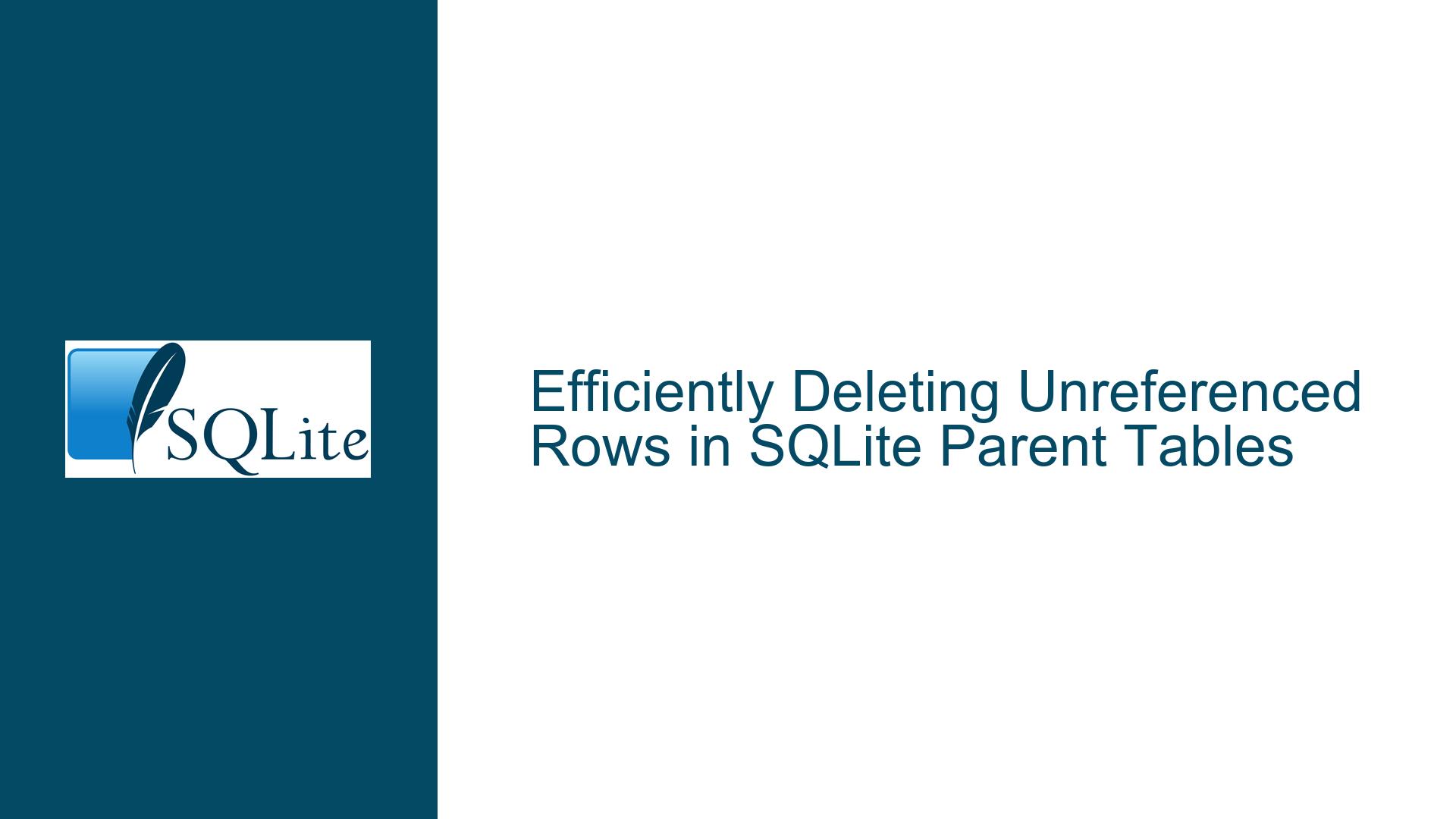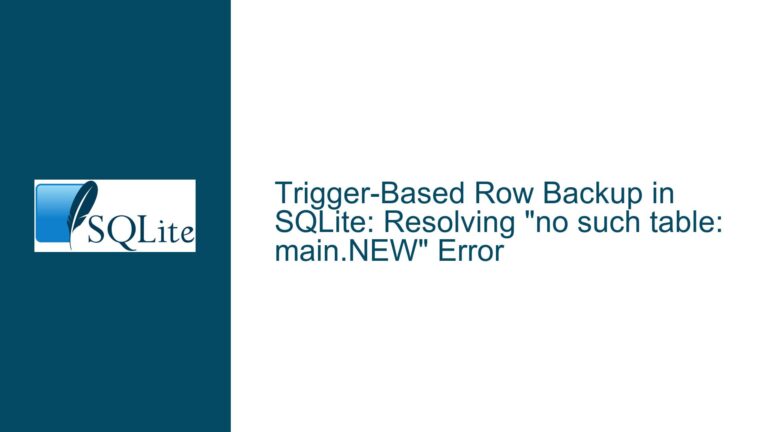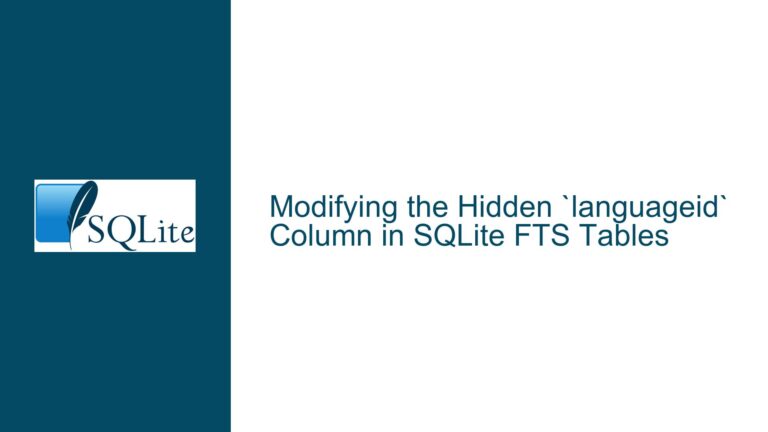Efficiently Deleting Unreferenced Rows in SQLite Parent Tables
Understanding the Challenge of Deleting Unreferenced Rows in Parent Tables
In SQLite, managing relationships between parent and child tables is a common task, especially when dealing with foreign key constraints. One of the challenges that arise is the need to delete rows from a parent table that are no longer referenced by any child tables. This situation is particularly tricky when the child tables use ON DELETE RESTRICT on their foreign keys, as this constraint prevents the deletion of a parent row if it is still referenced by any child row.
The core issue here is that SQLite does not provide a built-in mechanism to automatically skip or ignore rows that are still referenced by child tables when executing a DELETE statement on the parent table. This means that developers must find a way to identify and delete only those rows in the parent table that are not referenced by any child tables, without violating the foreign key constraints.
The problem is further complicated by the fact that the solution must be robust and maintainable. Manually walking through all child tables to build a list of references is not only time-consuming but also prone to errors, especially when new child tables are added to the schema. This approach would require constant updates to the deletion logic, which is far from ideal.
The Impact of Foreign Key Constraints on Deletion Operations
Foreign key constraints play a crucial role in maintaining the integrity of the data in a relational database. In SQLite, these constraints ensure that a row in a child table cannot reference a non-existent row in the parent table. When a foreign key constraint is defined with ON DELETE RESTRICT, it prevents the deletion of a parent row if it is still referenced by any child row. This constraint is essential for preserving the relational integrity of the database, but it also introduces challenges when attempting to delete unreferenced rows from the parent table.
The ON DELETE RESTRICT constraint is just one of several options available for handling deletions in SQLite. Other options include ON DELETE CASCADE, which automatically deletes all child rows when the parent row is deleted, and ON DELETE SET NULL, which sets the foreign key column in the child table to NULL when the parent row is deleted. However, these options are not always suitable, especially when the goal is to delete only those parent rows that are no longer referenced by any child tables.
In the context of the problem at hand, the ON DELETE RESTRICT constraint means that any attempt to delete a parent row that is still referenced by one or more child rows will result in a foreign key constraint violation. This behavior is by design, as it ensures that the database remains in a consistent state. However, it also means that developers must find a way to identify and delete only those parent rows that are not referenced by any child tables, without triggering these constraint violations.
Strategies for Identifying and Deleting Unreferenced Parent Rows
Given the challenges posed by foreign key constraints, there are several strategies that can be employed to identify and delete unreferenced rows from a parent table in SQLite. Each of these strategies has its own advantages and disadvantages, and the choice of strategy will depend on the specific requirements of the database schema and the application.
One approach is to manually walk through all child tables and build a list of references to the parent table. This can be done using a series of SELECT statements that retrieve the foreign key values from each child table and then use these values to identify the rows in the parent table that are still referenced. Once the list of referenced parent rows has been compiled, a DELETE statement can be executed to remove the unreferenced rows from the parent table.
However, this approach has several drawbacks. First, it requires duplicating the logic that is already implemented by the foreign key system, which is not ideal from a maintenance perspective. Second, it requires updating the deletion logic whenever a new child table is added to the schema, which can be error-prone and time-consuming. Finally, this approach can be inefficient, especially when dealing with large datasets, as it involves multiple queries and potentially large intermediate result sets.
Another approach is to use a single DELETE statement with a subquery that identifies the unreferenced rows in the parent table. This can be done by using the NOT IN operator to exclude rows that are still referenced by any child table. For example, the following query could be used to delete unreferenced rows from a parent table named parent:
DELETE FROM parent
WHERE id NOT IN (
SELECT pid FROM child1
UNION
SELECT pid FROM child2
UNION
SELECT pid FROM child3
);
In this query, the subquery retrieves the foreign key values (pid) from each child table (child1, child2, and child3) and combines them using the UNION operator. The NOT IN operator is then used to exclude these values from the DELETE statement, ensuring that only unreferenced rows are deleted from the parent table.
This approach has several advantages. First, it leverages the existing foreign key relationships, eliminating the need to manually walk through the child tables. Second, it is more maintainable, as it does not require updating the deletion logic when new child tables are added to the schema. Finally, it is more efficient, as it involves a single query and avoids the need for large intermediate result sets.
However, this approach also has some limitations. First, it requires that all child tables be known in advance, which may not always be the case in a dynamic schema. Second, it can be less efficient when dealing with a large number of child tables, as the subquery can become complex and time-consuming to execute. Finally, it may not be suitable for all use cases, especially when the goal is to delete rows from the parent table in a more granular or conditional manner.
Implementing a Robust Solution with PRAGMA Statements and Database Backups
To implement a robust solution for deleting unreferenced rows from a parent table in SQLite, it is important to consider the use of PRAGMA statements and database backups. PRAGMA statements are special commands in SQLite that are used to modify the behavior of the database engine or to retrieve metadata about the database. In the context of deleting unreferenced rows, the PRAGMA foreign_keys statement can be used to enable or disable foreign key constraints, which can be useful for testing and debugging purposes.
For example, the following PRAGMA statement can be used to disable foreign key constraints:
PRAGMA foreign_keys = OFF;
With foreign key constraints disabled, it is possible to execute a DELETE statement on the parent table without triggering any constraint violations. However, this approach should be used with caution, as it can lead to data inconsistency if not handled properly. After the deletion operation is complete, the foreign key constraints should be re-enabled using the following PRAGMA statement:
PRAGMA foreign_keys = ON;
In addition to using PRAGMA statements, it is also important to consider the use of database backups when performing deletion operations. A database backup can serve as a safety net in case something goes wrong during the deletion process, allowing you to restore the database to its previous state. SQLite provides several options for creating database backups, including the .backup command in the SQLite command-line interface and the sqlite3_backup_init API function in the SQLite C interface.
For example, the following command can be used to create a backup of an SQLite database using the command-line interface:
sqlite3 mydatabase.db ".backup mydatabase_backup.db"
By creating a backup before performing a deletion operation, you can ensure that you have a fallback option in case the operation does not go as planned. This is especially important when dealing with large or complex databases, where the risk of data loss or corruption is higher.
Conclusion
Deleting unreferenced rows from a parent table in SQLite can be a challenging task, especially when dealing with foreign key constraints and dynamic schemas. However, by understanding the impact of foreign key constraints, leveraging subqueries to identify unreferenced rows, and using PRAGMA statements and database backups to ensure data integrity, it is possible to implement a robust and maintainable solution. The key is to strike a balance between efficiency, maintainability, and data integrity, ensuring that the database remains in a consistent state while minimizing the risk of errors or data loss.






